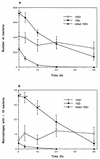Cytokine induction in murine macrophages infected with virulent and avirulent Rhodococcus equi
- PMID: 9573060
- PMCID: PMC108134
- DOI: 10.1128/IAI.66.5.1848-1854.1998
Cytokine induction in murine macrophages infected with virulent and avirulent Rhodococcus equi
Abstract
To look for a possible correlation between the virulence of Rhodococcus equi and its cytokine-inducing capacity, we evaluated intracellular survival and measured cytokine induction by mouse macrophages infected with a virulent strain containing an 85-kb plasmid and expressing VapA (103+), its avirulent plasmid-cured derivative (103-), and heat-killed 103+ (HK). After incubation with similar numbers of bacteria, macrophages infected with 103- contained significantly more organisms than those infected with 103+ or HK. The number of bacteria in the macrophages infected with 103- and HK decreased progressively, whereas the 103+ numbers remained constant over 48 h. Interleukin 1beta (IL-1beta), IL-6, IL-10, IL-12 p40, and tumor necrosis factor alpha (TNF-alpha) mRNA induction peaked at 4 h and returned to baseline between 12 and 48 h postinfection. IL-1beta, IL-6, IL-10, and TNF-alpha concentrations assessed by enzyme-linked immunosorbent assay generally agreed well with mRNA expression; IL-12 could, however, not be detected. For all the cytokines detected, mean concentrations in the supernatants were consistently higher in the 103(-)-infected monolayers than in those infected with 103+, although, with the exception of IL-1beta, the differences were not statistically significant. R. equi HK was a poor inducer of cytokine production. In conclusion, virulent and avirulent R. equi strains induced similar levels of cytokine synthesis. The slightly greater induction of most cytokines observed following infection with 103- is likely secondary to greater uptake by macrophages rather than to a direct role of VapA or another plasmid-encoded product in downregulating cytokine induction.
Figures




Similar articles
-
Cytokine expression by neutrophils of adult horses stimulated with virulent and avirulent Rhodococcus equi in vitro.Vet Immunol Immunopathol. 2009 Jan 15;127(1-2):135-43. doi: 10.1016/j.vetimm.2008.10.003. Epub 2008 Oct 17. Vet Immunol Immunopathol. 2009. PMID: 19019457
-
Tumour necrosis factor and interferon-gamma are required in host resistance against virulent Rhodococcus equi infection in mice: cytokine production depends on the virulence levels of R. equi.Immunology. 1999 Jan;96(1):122-7. doi: 10.1046/j.1365-2567.1999.00657.x. Immunology. 1999. PMID: 10233686 Free PMC article.
-
Modulation of cytokine response of pneumonic foals by virulent Rhodococcus equi.Infect Immun. 1999 Oct;67(10):5041-7. doi: 10.1128/IAI.67.10.5041-5047.1999. Infect Immun. 1999. PMID: 10496876 Free PMC article.
-
Pathogenesis and virulence of Rhodococcus equi.Vet Microbiol. 1997 Jun 16;56(3-4):257-68. doi: 10.1016/s0378-1135(97)00094-1. Vet Microbiol. 1997. PMID: 9226840 Review.
-
Resistance of Rhodococcus equi to acid pH.Int J Food Microbiol. 2000 Apr 10;55(1-3):295-8. doi: 10.1016/s0168-1605(00)00172-0. Int J Food Microbiol. 2000. PMID: 10791761 Review.
Cited by
-
Foal monocyte-derived dendritic cells become activated upon Rhodococcus equi infection.Clin Vaccine Immunol. 2009 Feb;16(2):176-83. doi: 10.1128/CVI.00336-08. Epub 2008 Dec 24. Clin Vaccine Immunol. 2009. PMID: 19109450 Free PMC article.
-
Rhodococcus equi-Derived Extracellular Vesicles Promoting Inflammatory Response in Macrophage through TLR2-NF-κB/MAPK Pathways.Int J Mol Sci. 2022 Aug 28;23(17):9742. doi: 10.3390/ijms23179742. Int J Mol Sci. 2022. PMID: 36077142 Free PMC article.
-
A real-time impedance based method to assess Rhodococcus equi virulence.PLoS One. 2013;8(3):e60612. doi: 10.1371/journal.pone.0060612. Epub 2013 Mar 28. PLoS One. 2013. PMID: 23555995 Free PMC article.
-
Necrotic death of Rhodococcus equi-infected macrophages is regulated by virulence-associated plasmids.Infect Immun. 2004 Feb;72(2):853-62. doi: 10.1128/IAI.72.2.853-862.2004. Infect Immun. 2004. PMID: 14742529 Free PMC article.
-
VapA of Rhodococcus equi binds phosphatidic acid.Mol Microbiol. 2018 Feb;107(3):428-444. doi: 10.1111/mmi.13892. Epub 2017 Dec 22. Mol Microbiol. 2018. PMID: 29205554 Free PMC article.
References
-
- Arlotti M, Zoboli G, Moscatelli G L, Magnati G, Maserati R, Borghi V, Andreoni M, Libanore M, Bonazzi L, Piscina A, Ciammarughi R. Rhodococcus equi infection in HIV-positive subjects: a retrospective analysis of 24 cases. Scand J Infect Dis. 1996;28:463–467. - PubMed
-
- Bern D, Lämmler C. Relationship between haemagglutination and HeLa-cell adherence of Rhodococcus equi. J Vet Med B. 1996;43:147–153. - PubMed
-
- Chomczynski P, Sacchi N. Single-step method of RNA isolation by acid guanidinium thiocyanate-phenol-chloroform extraction. Anal Biochem. 1987;162:156–159. - PubMed
-
- de la Pena-Moctezuma A, Prescott J F. Association with HeLa cells by Rhodococcus equi with and without the virulence plasmid. Vet Microbiol. 1995;46:383–392. - PubMed
Publication types
MeSH terms
Substances
LinkOut - more resources
Full Text Sources

